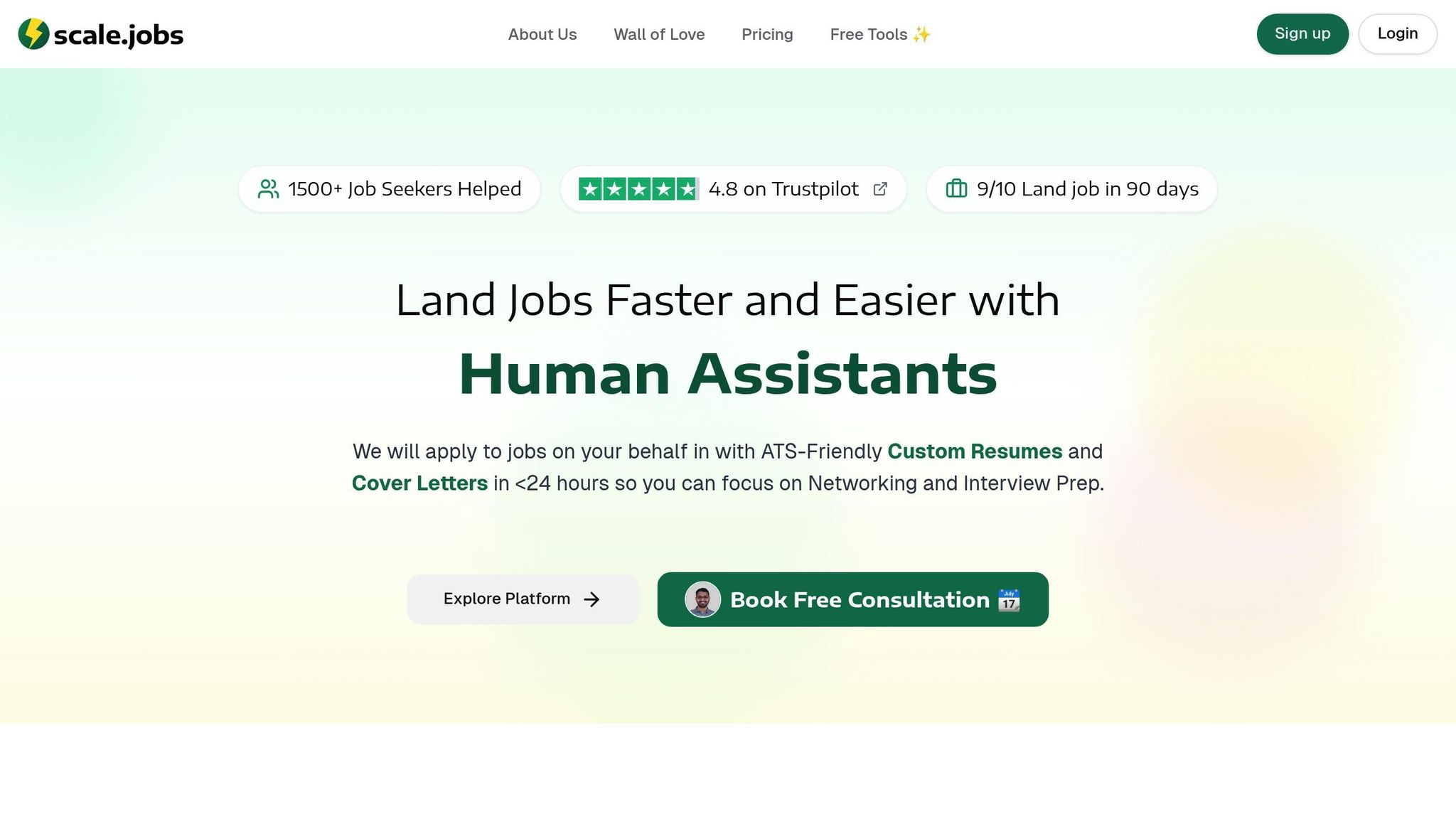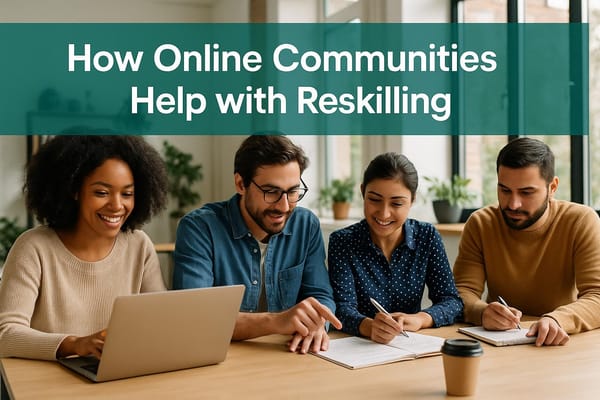7 Networking Etiquette Tips for Job Seekers
Master essential networking etiquette to build meaningful relationships that unlock job opportunities and enhance your career prospects.

Networking can be the key to unlocking job opportunities. In fact, 46% of jobs secured by scale.jobs users come from personal networking efforts. But it's not just about collecting business cards - it's about building meaningful relationships. Here’s a quick breakdown of 7 essential networking tips to help you stand out:
- Research First: Know the person and their organization before reaching out.
- Perfect Your Introduction: Craft a concise, impactful pitch (under 30 seconds).
- Listen More: Follow the 80/20 rule - listen 80%, talk 20%.
- Know When to Step Back: Keep conversations brief and leave a positive impression.
- Follow Up Smartly: Send thoughtful, tailored follow-ups to maintain connections.
- Leverage Online Platforms: Build a strong digital profile and engage professionally.
- Maintain Relationships: Regularly interact with your network to keep connections strong.
How to Network: Networking Etiquette Tips for Professionals
1. Do Your Homework First
Before reaching out to someone, take the time to research thoroughly. This effort helps you make a strong and personalized first impression.
Here’s where to focus your research on the individual:
- Achievements: Look into their career milestones or recognitions.
- Current Role: Understand what they do now and how it fits into their career path.
- Education and Certifications: Knowing their academic background can help establish common ground.
- Published Work: Articles, blogs, or papers they’ve written can offer insights into their expertise.
Don’t forget to dig into the organization as well:
- Recent Announcements: Check for press releases or updates.
- Major Projects: Learn about their key initiatives or focus areas.
- Market Position: Understand where the company stands in its industry.
- Culture and Challenges: Knowing their values and current struggles can guide your approach.
Find shared connections or experiences - like attending the same school, working at the same company, or participating in similar events. Mentioning these in your outreach can help establish an immediate rapport. For example, referencing a shared alma mater or a mutual professional network can make your introduction feel more personal.
Stay informed about industry trends and company developments to engage in meaningful conversations. A well-prepared approach lays the groundwork for successful networking.
2. Perfect Your Introduction
Create a clear and impactful elevator pitch that showcases your expertise and sparks meaningful conversations.
Here’s how to structure your professional introduction:
- Start with your current role: Briefly share your position and area of expertise. For example, "I'm a software engineer specializing in cloud infrastructure with 5 years of experience", or "I recently earned an MBA from Stanford, focusing on digital marketing."
- Highlight a key achievement: Mention something that sets you apart and aligns with your goals. For instance, "I led three product launches that boosted revenue by 40% year-over-year", or "I designed an AI tool that cut customer service response times by 65%."
- State your objective: Clearly articulate your purpose, whether it’s seeking new opportunities, mentorship, or connections.
Framework for Your Introduction
Use this simple structure to organize your pitch:
| Component | Example | Duration |
|---|---|---|
| Current Status | "I'm a UX designer with 3 years of experience..." | 5–7 seconds |
| Key Achievement | "...who recently revamped a Fortune 500 app..." | 8–10 seconds |
| Goal/Ask | "...and I'm looking to connect with fintech leaders." | 5–7 seconds |
This framework helps you stay concise and adaptable for various networking scenarios.
Tips for Delivering Your Pitch
- Keep it under 30 seconds, make eye contact, and use natural gestures.
- Record yourself to review your tone, pacing, and body language.
- Adjust your energy and tone based on the setting.
- Prepare different versions for in-person events, LinkedIn messages, or email introductions.
Avoid These Common Mistakes
- Speaking too quickly or rushing through your pitch.
- Adding unnecessary details that dilute your message.
- Being vague about your objectives or goals.
- Focusing only on what you want instead of how you can contribute.
- Using too much industry jargon that may confuse your audience.
3. Listen More Than You Speak
Active listening is one of the most effective networking skills you can develop. It goes beyond just hearing words - it’s about truly understanding and engaging with the person you’re speaking to. By focusing on their perspective, you can build deeper, more meaningful connections.
The 80/20 Rule of Networking
Follow the 80/20 rule: listen 80% of the time and speak for just 20%. This approach allows you to:
- Learn about industry trends and opportunities
- Pinpoint challenges where you might offer solutions
- Strengthen your connections by showing genuine interest
- Respect the expertise and insights of others
How to Practice Active Listening
Use these techniques to show you’re fully engaged during conversations:
| Technique | What It Involves | Why It Works |
|---|---|---|
| Mirror Body Language | Match their posture and gestures subtly | Builds a natural sense of connection |
| Use Verbal Affirmations | Phrases like "I see" or "Tell me more" | Signals interest without interrupting |
| Note Key Details | Remember specifics about their work or challenges | Helps you follow up meaningfully |
| Ask Follow-up Questions | Expand on their points with thoughtful questions | Shows you’re paying attention |
Asking the Right Questions
Well-crafted questions can keep the conversation flowing and uncover valuable insights. Try this approach:
- Start Broad: For example, "What trends are shaping your industry right now?"
- Dig Deeper: Follow up with, "How is your team navigating those changes?"
- Make It Personal: Ask, "What’s been your most effective strategy so far?"
These types of questions encourage open, detailed responses while keeping the discussion natural.
Mistakes to Avoid While Listening
Even with the best intentions, it’s easy to make missteps. Watch out for these:
- Interrupting to Share Your Story: Wait for a pause before adding your own experiences.
- Breaking Eye Contact: Stay focused on the person you’re speaking with - don’t scan the room.
- Asking Vague Questions: Do your homework so you can ask specific, informed questions.
- Checking Your Phone: Keep it out of sight to show you’re fully present.
Prioritize Quality Over Quantity
Instead of spreading yourself thin, focus on meaningful interactions. Delegate routine tasks, like job applications, to free up time for networking. When you truly listen and show curiosity, you’ll uncover valuable opportunities and build lasting professional relationships. Genuine interest in others’ experiences often opens doors you didn’t even know existed.
4. Know When to Step Back
Once you've mastered effective listening, it's equally important to know when to step back to maintain the quality of your connections. Research indicates that networking conversations are most impactful when kept to 7–9 minutes, resulting in 33% higher positive recall compared to longer interactions.
Reading Social Cues
Pay attention to subtle signals that suggest it's time to wrap up:
| Signal Type | Examples | How to Respond |
|---|---|---|
| Verbal | "It was great meeting you" | Thank them and exchange contact info |
| Physical | Glancing at a watch, stepping back | Start your exit strategy |
| Conversational | Shorter responses, less engagement | Politely signal your exit |
The 5-Step Exit Strategy
Here’s a simple plan to leave conversations gracefully:
- Show appreciation: Thank them sincerely for their time.
- Outline next steps: For example, "I'll follow up via LinkedIn next week."
- Exchange contact information: If it feels appropriate.
- Set expectations: Be clear about future communication.
- End professionally: Conclude with a warm goodbye.
Follow-up Timing and Boundaries
Overdoing follow-ups can hurt your professional relationships. A survey found that 72% of professionals view more than two follow-ups within 30 days as excessive. Stick to this timeline:
- First follow-up: Reach out 7–10 days after the initial meeting.
- Final attempt: If there's no response, wait another three weeks before trying again.
"I realize I followed up too frequently last month - I was enthusiastic but should have respected your time. I'll wait for your cue on next steps."
This kind of acknowledgment can repair 68% of strained professional relationships.
Protecting Contact Information
Always get permission before sharing someone’s contact details. According to The BD School's 2024 study, professionals who respect this boundary see a 40% higher response rate in their networking efforts.
Digital Networking Boundaries
When networking online, follow these guidelines:
- Wait 24–48 hours after the initial contact before following up.
- Limit yourself to two channels for connection attempts.
- Pay attention to response patterns.
- Respect "do not disturb" signals or indicators.
Notably, 83% of professionals consider sharing someone’s contact information without consent a major breach of networking etiquette.
Using Technology Wisely
Leverage digital tools to keep track of your networking efforts. These tools can help you monitor:
- Preferred contact methods
- Dates of your last interaction
- Follow-up schedules
- Response trends
Review your records every two weeks to ensure your communication stays appropriate and timely.
5. Send Smart Follow-ups
Follow-ups are a great way to strengthen connections and create future opportunities. By acting promptly and thoughtfully, you can keep the momentum going while maintaining the respectful boundaries and engagement strategies mentioned earlier.
Crafting Meaningful Follow-ups
A strong follow-up message includes key elements that show you're invested in the relationship. Here's a quick guide:
| Element | Purpose | Example |
|---|---|---|
| Context Reminder | Reintroduce yourself and the situation | "Thank you for discussing AI implementation strategies at the Tech Summit." |
| Specific Reference | Show you were paying attention | "Your insights about machine learning in healthcare were very valuable." |
| Action Item | Encourage further conversation | "I'd love to learn more about the research paper you mentioned." |
| Clear Next Step | Outline what happens next | "Would you be open to a brief virtual coffee meeting next week?" |
Personalizing Your Message
Tailor your follow-up to make it more impactful. Here are a few ways to do that:
- Industry Insights: Mention trends or challenges you discussed.
- Mutual Connections: Point out shared networks or acquaintances.
- Collaboration Points: Highlight potential areas for working together.
- Resource Exchange: Share any materials or tools you promised during your conversation.
Digital Follow-up Best Practices
When following up online, keep your messages concise and professional. Here are some tips:
- Subject Lines: Use clear and specific subjects like "Following Up – AI Discussion from [Event Name]."
- Conciseness: Keep your message brief and to the point.
- Tone: Maintain a professional yet friendly tone.
- Formatting: Use short paragraphs and clear spacing to improve readability.
Platform-Specific Etiquette
Different platforms call for different follow-up styles. Here's a quick overview:
| Platform | Best Practice |
|---|---|
| Use a formal structure with a clear subject line and prompt follow-up. | |
| Keep it professional but conversational, and follow up soon after meeting. | |
| In-Person Events | Reference specific details from the event and send your follow-up within 24 hours. |
Adding Value to Your Follow-ups
Make your follow-up stand out by offering more than just a thank-you. Consider:
- Sharing relevant industry reports or resources.
- Introducing them to someone in your network (with their permission).
- Suggesting events or opportunities they might find interesting.
- Offering help with challenges they mentioned.
6. Use Online Networks Well
Professional networks play a key role for job seekers today. To get the most out of these platforms, you need a thoughtful approach that combines active engagement with a professional tone.
Build a Strong Digital Profile
Your online profile often serves as your first impression. Here are some ways to make it stand out:
| Profile Component | What to Do | Why It Matters |
|---|---|---|
| Profile Photo | Choose a professional headshot with a plain background | Creates instant trust |
| Headline | Include key industry terms along with your current role or career goal | Improves your searchability |
| About Section | Write a concise summary that highlights your skills and value | Clearly showcases your expertise |
| Experience | Focus on achievements with specific, measurable outcomes | Proves your impact and results |
Once your profile is polished, it’s time to focus on meaningful engagement.
Engage Thoughtfully
Stay active on professional networks by commenting on relevant posts, sharing your own insights, and personalizing connection requests. When you share content, aim for posts that:
- Highlight your industry experience or expertise
- Share lessons learned from your career
- Provide commentary on relevant news
- Showcase the results of your projects or initiatives
This type of interaction helps build credibility and fosters connections.
Keep It Professional
As you interact online, it’s important to maintain a professional tone. Here’s how:
- Stick to standard business hours for your activity
- Avoid overloading your network with too many posts or comments
- Use clear, professional language in all interactions
- Focus on building relationships before making requests
Regularly update your profile with new accomplishments, stay active in discussions, and review your privacy settings to ensure your digital presence remains current and professional.
7. Keep Connections Strong
Building a professional network isn’t just about meeting people - it’s about maintaining those relationships over time. Regular interaction helps build trust and keeps your connections active.
For example, if someone in your network achieves a milestone or earns a certification, send them a short, personal message like:
"Congrats on completing your AWS certification! Balancing that with a full-time job is impressive. How did you manage it all?"
When sharing your own updates, go beyond just talking about yourself. Offer insights, share trends, or provide helpful resources. By blending updates about your achievements with genuine acknowledgment of others’ successes, you create stronger, more meaningful relationships.
How Scale.jobs Helps Job Seekers

Applying for jobs can be time-consuming, leaving little room to focus on networking and interview preparation. Scale.jobs simplifies this process by handling the repetitive tasks of job applications, so you can concentrate on building meaningful professional relationships.
With Scale.jobs, human virtual assistants craft personalized, ATS-friendly resumes and cover letters and submit applications within 24 hours. This efficient approach has helped 93% of users secure a job within three months.
"I would recommend trying out scale.jobs to anyone looking to make more time in their schedule for interview prep and networking, so that the repetitive portion of the job application process can be outsourced. I personally feel it's good value for money."
Here’s a quick look at the service's impact:
| Metric | Result |
|---|---|
| Users Landing Jobs in 90 Days | 9 out of 10 |
| Time Saved on Job Search | 40% reduction |
| Users Getting Quick Results | 70% receive refund within 30 days |
By outsourcing the repetitive parts of the job application process, you can focus your energy on networking and interview preparation. Scale.jobs also offers free tools to support your job search, including:
- Resume ATS Checker
- Cover Letter Generator
- Job Applications Tracker
- Interview Questions Predictor
- Portfolio Website Generator
At just $4 per hour, this service is both affordable and effective, with users reporting a 200-fold return on investment through saved time and potential salary gains. This allows you to dedicate more attention to the professional connections that can advance your career.
Scale.jobs not only handles the busy work but also provides the resources you need to make every professional interaction count, ensuring your job search is both efficient and productive.
Conclusion
Networking etiquette plays a key role in advancing your career. Following these principles not only boosts your professional image but also makes your job search more effective. By applying these seven tips - from thorough preparation to nurturing long-term connections - you can create meaningful relationships that help propel your career forward.
Here are some practical ways to incorporate these tips into your networking efforts:
- Consistently follow etiquette guidelines to leave a positive impression.
- Invest time in building quality relationships rather than chasing quantity.
- Leverage tools and platforms to simplify job applications and networking.
- Track your networking efforts to stay organized and focused.
By sticking to these strategies, you can make steady progress in your career. Tools like scale.jobs can handle repetitive tasks, giving you more time to focus on networking and interview prep.
FAQs
What’s the best way to research a networking contact to make a great first impression?
To make a strong first impression when reaching out to a networking contact, it’s important to do some thoughtful research beforehand. Start by reviewing their LinkedIn profile to understand their professional background, current role, and skills. Look for any shared connections, mutual interests, or commonalities that could serve as conversation starters.
Next, explore their company’s website or recent news to familiarize yourself with their organization’s goals, achievements, or challenges. If they’ve published articles, given talks, or shared posts online, take the time to read or watch them; this shows genuine interest in their work.
By preparing with this information, you’ll be able to tailor your outreach, ask insightful questions, and demonstrate that you value their time, which can leave a lasting positive impression.
How can I maintain professional relationships after a networking meeting?
Maintaining professional relationships after a networking meeting is key to building meaningful, long-term connections. Here are a few strategies to help:
- Follow up promptly: Send a thank-you email or message within 24–48 hours of your meeting. Mention specific points from your conversation to show genuine interest.
- Stay in touch: Periodically check in with your contacts, whether it’s sharing an article they might find useful, congratulating them on a career milestone, or simply asking how they’re doing.
- Offer value: Networking is a two-way street. Look for ways to help your connections, such as offering insights, introductions, or resources they might need.
Consistency and authenticity are key when nurturing professional relationships. Small but thoughtful gestures can go a long way in keeping your network strong over time.
How can I effectively balance networking and job applications during my job search?
Balancing networking and job applications is key to a successful job search. To make the most of your time, prioritize networking by reaching out to professionals in your industry, attending events, and engaging on platforms like LinkedIn. Building meaningful connections can open doors to opportunities that might not be advertised.
To save time on job applications, consider using services like Scale.jobs, where human virtual assistants handle the application process for you. This allows you to focus on networking and preparing for interviews, ensuring you're putting your best foot forward. With tools like resume and cover letter generators, Scale.jobs also helps streamline the application process, so you can maximize your efforts across all aspects of your search.




